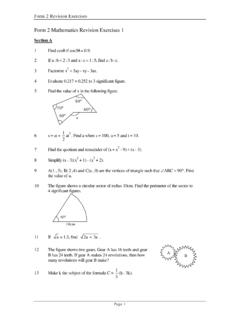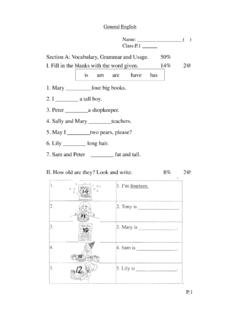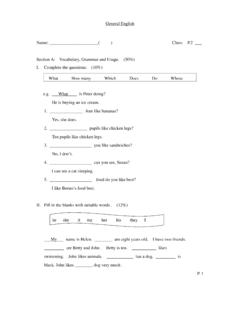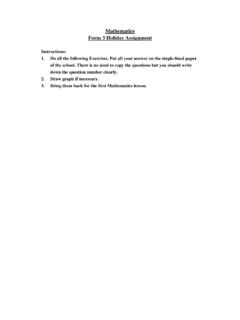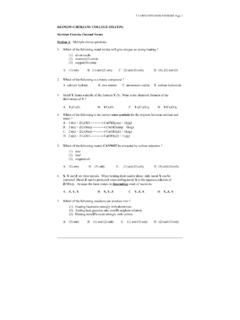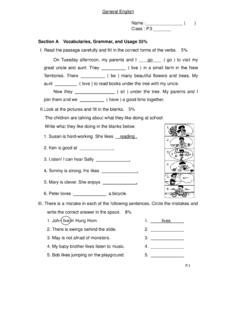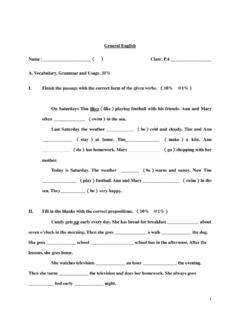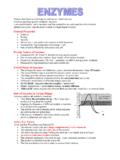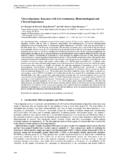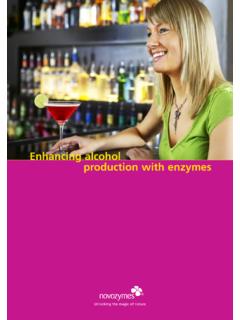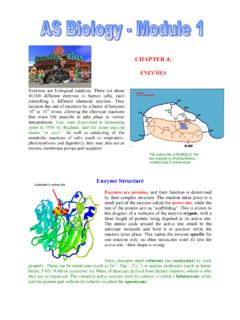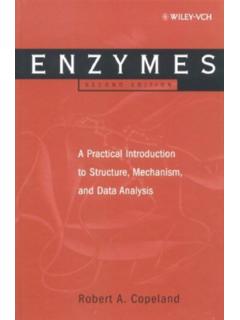Transcription of Enzymes - hkedcity.net
1 Buddhist Chi Hong Chi Lam Memorial College Bio. Notes (by Denise Wong) The Cell .. Page 49 Enzymes Syllabus : . The protein nature of Enzymes . The role of Enzymes as catalysts in lowering activation energy through the formation of enzyme-substrate complex. The concept of active site and enzyme specificity. The induced-fit model of enzyme action. The effects of temperature, pH, enzyme concentration and substrate concentration on the rate of enzyme reactions. The effects of cofactors, reversible inhibitors (competitive and non-competitive) and irreversible inhibitors on the rate of enzymatic reactions.
2 End-product inhibition. The application of Enzymes , biological washing powder and meat tenderiser. Introduction : The chemical reactions which occur within organisms are collectively known as metabolism. It is estimated that over 1000 different reactions occur in an individual cell. There are two types : anabolism and catabolism. Comparison between anabolism and catabolism : Anabolism Catabolism Building up processes in cell A + B C building of protein molecules from different amino acids Breaking down process in cell X Y + Z deamination Energy required, endogenic Energy is released, exogenic Both processes need Enzymes to speed up the reaction Enzymes as organic catalysts.
3 Enzymes are organic catalyst produced within the living organisms which speed up chemical reactions, by lowering the activation energy, in the living organisms but themselves remain unchanged at he end of the reaction. [Note] Activation energy is the energy required to make the substances react. As heat is often the source of activation energy, Enzymes often dispense with the need for this heat and so allow reactions to take place at lower temperature In molecular terms, the enzyme combines with the substrate molecules to form an enzyme-substrate complex.
4 In such close contact the substrate molecules may be distorted and hence easily react to form an enzyme-product complex which then split to release the product molecule and the enzyme . In this way, the activation energy is lowered. Since they are not altered by the reactions they catalyse, so that they can be reused. In other words they are effective in very small amount. ** Insert p304 fig ** Fig. 53 How enzyme lower the activation energy. Buddhist Chi Hong Chi Lam Memorial College Bio. Notes (by Denise Wong) The Cell.
5 Page 50 Enzymes are normally larger than the substrate molecules they act upon. Only a small part of the enzyme molecule actually comes into contact with the substrate. This region is called active site. Mechanism of Enzymatic Actions : Lock and Key Hypothesis : It was suggested by Fischer in 1890. On the surface of the enzyme molecule is specific site called the active site which has a distinctive configuration due to the unusual folding of the protein molecule and position of different chemical groups within the specific substrate molecules with the right shape can fit into the active site to form enzyme-substrate complex, thus the substrate and enzyme molecules act as the lock and key respectively.
6 BS I 3rd ed. P117 fig Fig. 54 The lock and key hypothesis of enzyme action. Induced Fit Theory : This is modified from lock and key hypothesis and was suggested by Koshland in 1959. In the presence of substrate the active site of the enzyme may change shape to fit the substrate the enzyme is flexible and moulds to fit the substrate molecule. This theory is stated based on the nature of enzyme --- protein molecule is flexible enough to allow conformational changes. BS I 3rd ed. P118 fig Fig. 55 The induced fit theory of enzyme action.
7 Buddhist Chi Hong Chi Lam Memorial College Bio. Notes (by Denise Wong) The Cell .. Page 51 Properties of enzyme : 1. It speeds up chemical reactions but remain undestroyed at the end of the reaction. it has the catalytic properties. 2. It works in either direction. it catalyses the forward and backward reaction to the same extent. The direction in which the reaction goes depends on the relative amounts of substrate and products present. The products are continuously removed to maintain the reaction in living organism.
8 A + B C + D 3. An enzyme changes the rate only at which chemical equilibrium is reached; it does not affect the position of the equilibrium. 4. An enzyme speeds up the rate of reaction by lowering the activation energy barrier. 5. It works rapidly and therefore is required in small quantity. 6. It is soluble in water and works in aqueous solution in living cells. 7. All Enzymes operate only on specific substrates. Only substrates of particular shape will fit the active site of an enzyme. 8. All Enzymes are proteins, some may have other associated molecules.
9 9. Enzyme may be denatured by excessive heat, extreme pH or various chemicals. This is because Enzymes are soluble proteins. Such extremities or chemicals cause Enzymes to coagulate by breaking down bonds in the molecule making them insoluble. The molecular configuration of the active site is changed. Hence the enzyme can no longer carry its catalytic function and is said to be denatured. Such changed are irreversible. The phenomenon is known as denaturation. activity of an enzyme is affected by temperature.
10 Activity is affected by pH of the medium. It worked best at an optimum pH. Enzymes work efficiently only in the presence of appropriate co-factors. Co-factors : It is a non-protein substance which is essential for some Enzymes to function efficiently. There are three types : a) Activators : are substances which are necessary for the functioning of certain Enzymes . They may assist in forming the E-S complex by moulding either the enzyme or substrate molecule into a more suitable shape. i) Enzyme thrombokinase, which converts prothrombin into thrombin during blood clotting, is activated by Calcium ions ; ii) Salivary amylase requires the presence of chloride ions before it converts starch into maltose.
